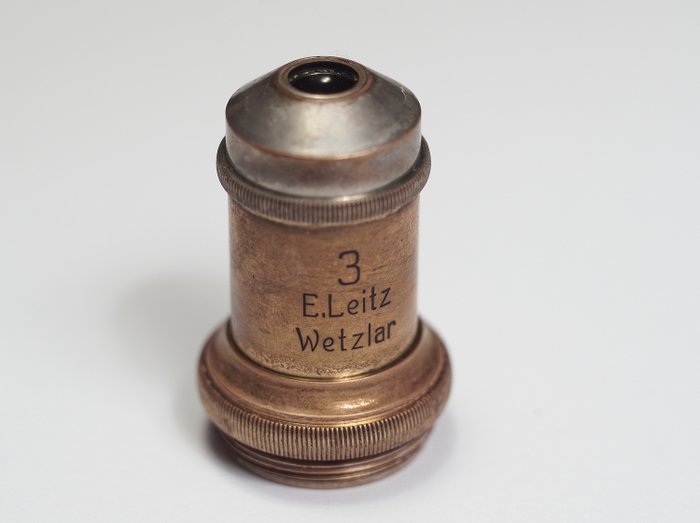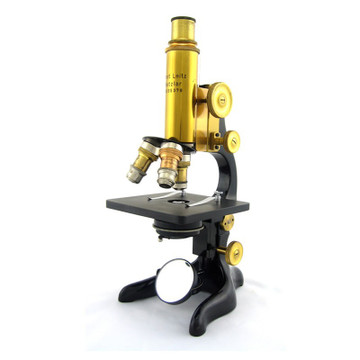
The objectives are each mounted on an adaptor with centering screws for use with this polarizing microscope. It takes a wide-diameter ocular with a large field of view. The body tube is nickel-plated and of wide diameter. One interval on the drum is equal to 0.001 mm. The fine focus is by a micrometer screw equipped with a divided drum for depth measurements. Above the joint is a curved arm that holds the both the fine focus and coarse focus knobs and carries a bracket to which is attached the unusual body tube. A nickel-plated lever is used to fix the desired angle. The upright is rectangular and has a joint for inclining the microscope. The base is blackened brass with a horseshoe-shape and beveled heel. *Thanks to Dr Tilman Halder for providing an exact date, as microscope number 337917, the very next number and precisely the same model, has a magnification card with the production date in the fall of 1938.Description This is a Leitz petrographic microscope, model SM, which features synchronic rotation of the nicol prisms above and below the stage as well as independent rotation of the polarizer and analyzer through 240 degrees. John Field for his expertise in the history of Leitz microscopes and some of the illustrations provided herein. As equipped, it sold in 1949 for what would be over $15,000 in 2013 dollars. The CM was stillīeing advertised in 1949. Supports from the foot, whereas the CMU model from about 1952 has squared off shaped supports. The CMU model which differs from this model only in that the model shown here has a rounded shape of the upright I am grateful to Dr John Field, an expert on Leitz microscopes, for this information on the evolution of the Leitz pol scopes. The CM model shown on this web page features an 'aa' model substage, and there were three others in succession, the a, b, and c. Then the BM was offered and included the mechanical stage as a standard fitting, whereas it was an extra accessory for this CM model. The next design was the AM which gave the stage rack and pinion focusing. This model, the CM, added rack and pinion focusing to the Bertrand lens, retaining the large diamter tube. The GM added a slide-focusing Bertrand lens. The KM model had a larger diameter 30 mm tube. Later on, these designs became less promoted, and others were offered. During the early period, the MI and MII were the more sophisticated models. The IIIM was the student pol microscope for many years. This is one of a long line of Leitz polarizing microscopes. In arranging for hundreds of Jewish families to escape the holocaust. During WWII Ernst Leitz II and his daughter were instrumental Inherited the firm from his father and ran it during the 1930's and 1940's.

The condenser on this microscope is known as the model 'aa' Berek condenser, and was the most complex of the models offered. The famous Dr Berek (who refused to work for the Nazis), who was responsible for many important concepts in optics and polarizing microscopy, worked for the LeitzĬompany until his death in 1949. There was even a specialized catalog for polarizing microscopes starting in 1893. By 1890 there was a catalog listing forĪ petrographic stand. Leitz started producing polarizing microscopes after 1885. HISTORY OF THE LEITZ POLARIZING MICROSCOPES.

A later objective signed: '170/0.17, 40/0.65,' and on the other side ' Leitz, WETZLAR, GERMANY.LEITZ,WETZLAR in insignia) and also 'A.U., N o9' and '5, 30X' A half lacquered-brass objective signed: '(E.




 0 kommentar(er)
0 kommentar(er)
